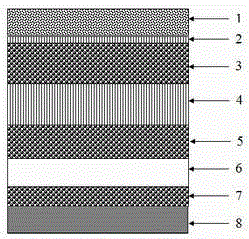Solar cell containing perovskite material and preparation method thereof
A technology of solar cells and perovskite materials, applied in the manufacture/processing of organic semiconductor devices, circuits, photovoltaic power generation, etc., can solve the problems of low manufacturing costs, achieve the effect of improving conversion rate and improving time stability
- Summary
- Abstract
- Description
- Claims
- Application Information
AI Technical Summary
Problems solved by technology
Method used
Image
Examples
Embodiment 1
[0031] 1) Low-iron glass is used as the light-transmitting layer;
[0032] 2) Use ITO (IndiumTinOxides) conductive glass as the transparent electrode layer;
[0033] 3) Prepare a NiO2 layer on the surface of conductive glass by spraying thermal decomposition technology, with a thickness of 8nm;
[0034] 4) Prepare a mixed solution of nickel acetone caproate, lithium acetate, and magnesium acetate tetrahydrate at a molar ratio of 2:1:6, spin coat it on the transition layer, and dry it at 350°C to prepare an electron transport layer; thickness 15nm;
[0035] 5) Prepare light absorbing layer:
[0036] a. Prepare PbI2 solution, the concentration is 1.5Mol / L, and the solvent is dimethylformamide;
[0037] b. Prepare CH3NH3I solution: the concentration is 8.5 mg / mL, and the solvent is isopropanol;
[0038] In-situ synthesis of perovskite materials by solution method: first spin-coat PbI2 solution on the electron transport layer, after drying, soak in CH3NH3I solution to grow per...
Embodiment 2
[0047] 1) Low-iron glass is used as the light-transmitting layer;
[0048] 2) Aluminum zinc oxide AZO conductive glass is used as the transparent electrode layer;
[0049] 3) Prepare a NiO2 layer on the surface of conductive glass by spraying thermal decomposition technology. Thickness 50nm;
[0050] 4) According to the molar ratio of 1:1:3, a mixed solution of nickel acetone hexanoate, lithium acetate, and magnesium acetate tetrahydrate was prepared, spin-coated on the transition layer, and dried at 400°C to prepare the electron transport layer; thickness 60nm;
[0051] 5) Prepare light absorbing layer:
[0052] a. prepare PbI2 solution, concentration is 0.5Mol / L, and solvent is dimethylformamide;
[0053] b. Prepare CH3NH3I solution: the concentration is 10 mg / mL, and the solvent is isopropanol;
[0054] In-situ synthesis of perovskite materials by solution method: spin-coat PbI2 solution on the electron transport layer first, dry it and soak it in CH3NH3I solution to g...
Embodiment 3
[0063] 1) Low-iron glass is used as the light-transmitting layer;
[0064] 2) Use fluorine tin oxide (FTO, fluorinated opedtinoxide) conductive glass as the transparent electrode layer;
[0065] 3) The NiO2 layer is made on the surface of conductive glass by spraying thermal decomposition technology. Thickness 6nm;
[0066] 4) According to the molar ratio of 1:1:10, a mixed solution of nickel acetone hexanoate, lithium acetate, and magnesium acetate tetrahydrate was prepared, spin-coated on the transition layer, and dried at 350°C to prepare the electron transport layer; thickness 98nm;
[0067] 5) Prepare light absorbing layer:
[0068] a. prepare PbI2 solution, concentration is 2.3Mol / L, and solvent is dimethylformamide;
[0069] b. Prepare CH3NH3I solution: the concentration is 7.5mg / mL, and the solvent is isopropanol;
[0070] In-situ synthesis of perovskite materials by solution method: first spin-coat PbI2 solution on the electron transport layer, after drying, soak...
PUM
| Property | Measurement | Unit |
|---|---|---|
| Thickness | aaaaa | aaaaa |
| Thickness | aaaaa | aaaaa |
| Thickness | aaaaa | aaaaa |
Abstract
Description
Claims
Application Information
 Login to View More
Login to View More - R&D
- Intellectual Property
- Life Sciences
- Materials
- Tech Scout
- Unparalleled Data Quality
- Higher Quality Content
- 60% Fewer Hallucinations
Browse by: Latest US Patents, China's latest patents, Technical Efficacy Thesaurus, Application Domain, Technology Topic, Popular Technical Reports.
© 2025 PatSnap. All rights reserved.Legal|Privacy policy|Modern Slavery Act Transparency Statement|Sitemap|About US| Contact US: help@patsnap.com

